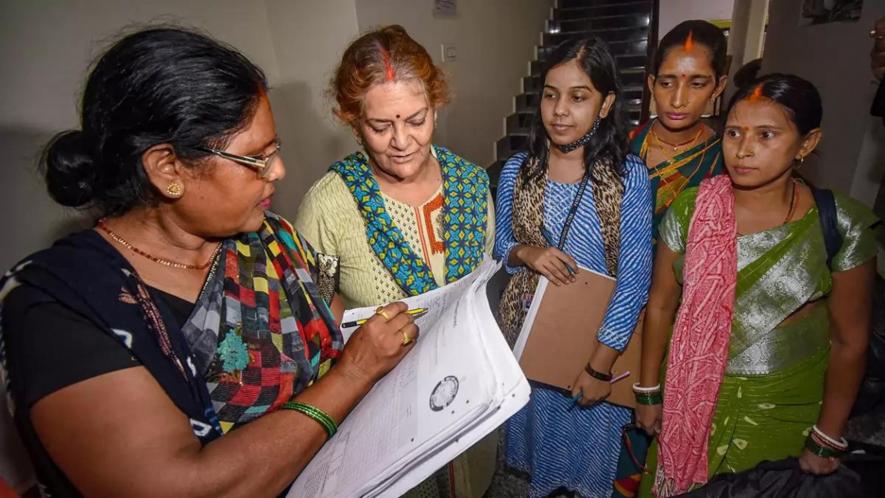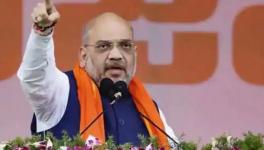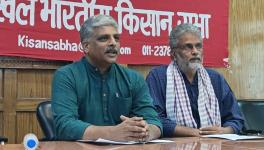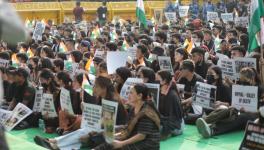Bihar Caste Survey Signals Battle Against Poverty Vs Politics of Religion

Enumerator staff collect information from residents for a caste-based census in Bihar. Image Courtesy: PTI
As many as 94,42,786 families out of 2,76,68,930 in Bihar are below the poverty line, finds the socio-economic data of the caste survey report, tabled by the Bihar government in the state legislature on Tuesday, November 7.
Though the backward classes, Scheduled Castes and Scheduled Tribes are the poorest among social groups in Bihar, the survey reveals that the malaise of poverty is all pervasive. The Extremely Backward Castes (EBCs), Other Backward Classes (OBCs) and the general category, each has 42.70%, 42.93%, 33.58%, 33.16% and 25.99% of the poor, respectively.
Chief Minister Nitish Kumar announced that his government would pay Rs 2,00,000 to each of the 94,42,786 poorest families to strengthen their financial condition. He also announced the same amount to each of the 1.65 unemployed youths and Rs 1 lakh to each of the 63,850 homeless families identified in the survey.
But what will have far-reaching political consequences is the Bihar government’s decision to raise the reservation limit for the Scheduled Castes, Scheduled Tribes, EBCs and OBCs in government jobs to 75% from the existing 50% (excluding the 10% Economically Weaker Section or EWS quota). In the new dispensation, the government proposes to raise the limit on reservations for the Scheduled Castes from 16% to 20%, for the Scheduled Tribes to 2% from 1% and for the OBCs (including EBCs) from 30% to 43%. The 10% quota for EWS and 35% for women is to remain unchanged.
Unlike other states, Bihar has accommodated the Pasmanda or backward Muslims in the job reservation category. Further, the Shershabadi and Duniya community Muslims (31.99% and 31.42% of whom are in the BPL category) will be beneficiaries of the expanded 43% reservation in jobs for OBCs and EBCs.
Bihar has a history of protracted caste and class conflicts, which had the disadvantaged unite and struggle against the numerically far fewer socially and economically prosperous classes under the banner of communist and socialist parties. Given this, the Bihar government’s decision to raise the job quota for the most needy sections is all set to smother the Bharatiya Janata Party’s (BJP’s) “policy” to organise society along religious lines, especially by fomenting a Hindu-Muslim fault line.
Bihar Template
By all accounts, Nitish Kumar is in the vanguard of uniting the non-BJP parties behind the social justice cause and secularism against the Sangh Parivar’s Hindutva politics. Through three conclaves at Patna, Bengaluru and Mumbai, as many as 28 parties demonstrated their unity under the Indian National Developmental Inclusive Alliance (INDIA) banner. They resolved to make the unemployment crisis, the growing social and economic disparities, rising poverty, rising prices and threats to democracy and the Constitution as the prime theme of their campaign against the BJP and it ‘politics of religious polarisation’.
The socio-economic details of Bihar’s caste survey and the decision to raise the quota in jobs and educational institutions was preceded by the government handing out appointment letters to over 1.20 lakh teachers at a mega job event in Patna on November 2 and publishing the enumeration of castes in the state on October 2.
The Rashtriya Janata Dal (RJD) spokesman and Member of Parliament Manoj Jha described the decision to raise the job quota from 50% to 75% as “historic”. Referring to the allegations of certain sections that injustice is being done to them in the name of caste, Jha said, “Justice to one section can never cause injustice to another. The government is making all efforts to end injustice and improve the condition of the poor in all the sections.”
The veteran Socialist leader and RJD national vice president, Shivanand Tiwary said, “I am appalled to see all-pervasive poverty in Bihar. In the context of these statistics, now the Centre must give special category status to Bihar and bring it on par with the relatively prosperous states of the country”.
The Congress party, which opposed the job quota in the 1990s, has virtually adopted what is now known as the “Nitish model”. The grand old party’s face Rahul Gandhi has been promising a national caste census and increasing the reservation limit in the run-up to elections in five states.
The narrative around people’s issues of unemployment, rural and urban poverty, price rise, health, housing and livelihood are all set to gain ground against Hindutva in the run-up to the 2024 Lok Sabha election.
The Bihar template has, apparently, unnerved the BJP. It is evident from the fact that the Union Home Minister Amit Shah, taking time off from the Assembly election campaign, landed in Bihar on November 6, addressed a rally at Muazaffarpur and exhorted attendees to participate in the ‘Pranpratishtha (life-infusing) ceremony at the Rama temple scheduled to be inaugurated in Ayodhya in January 2024.
He played the Hindutva card invoking the goddess of the Chhath festival to rid Bihar of Nitish Kumar. He reiterated the “threat” to Sanatan Dharma and attacked Nitish and the RJD president, former Bihar chief minister Lalu Prasad Yadav for “appeasing” minorities.
But thanks to Nitish and his young and energetic deputy, Tejaswhi Yadav working in harmony, Hindutva is hardly likely to work in Bihar. The BJP, apparently, fears the winds from Bihar travelling to other parts of India and challenging Prime Minister Narendra Modi’s electoral juggernaut in 2024.
Legacy of Left
The socio-economic report of Bihar's caste survey makes it easy to understand why the state was a centre of peoples’ movements for over half a century. The state witnessed many clashes between the landlords and landless classes from the 1970s to the 1990s.
At present, Bihar has the CPI-ML-Liberation as the strongest Left outfit with 12 MLAs in the state Assembly. The party, headed by Dipankar Bhattacharya as general secretary, is engaged in a continuous struggle for the uplift of the poor. Earlier, the Communist Party of India (CPI) was quite strong in Bihar; it had its leader of opposition in the Bihar House in 1970s.
While the Left parties have weakened considerably in neighbouring West Bengal, the CPI-ML-Liberation continues to hold its forte in Bihar. The three Left parties—CPI, CPM and CPI-ML-Liberation with 16 MLAs altogether—are part of Bihar’s ruling Mahagathbandhan, supporting the Nitish Kumar-Tejaswhi Yadav combine on the issues of employment, social justice, democracy and Constitution and oil INDIA’s wheels against Hindutva.
The author is a senior journalist, media educator, and researcher in folklore. The views are personal.
Get the latest reports & analysis with people's perspective on Protests, movements & deep analytical videos, discussions of the current affairs in your Telegram app. Subscribe to NewsClick's Telegram channel & get Real-Time updates on stories, as they get published on our website.
























